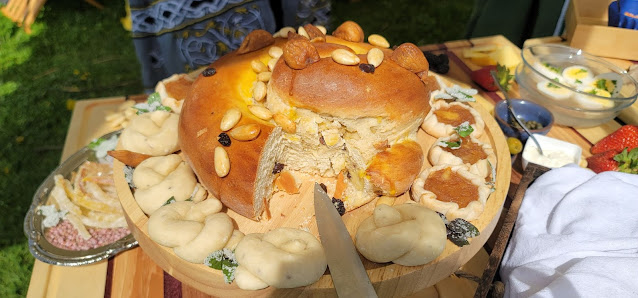Plates of Golden Fried Marzipan: A Renaissance Delight from Messisbugo
Among the lavish sweets presented at the 12th Night 2024 feast were these exquisite morsels: golden fried marzipan parcels inspired by Cristoforo di Messisbugo’s 16th-century banquet manual. As a court steward to the Duke of Ferrara, Messisbugo carefully documented not only recipes but the artistry of elite Renaissance dining. One such recipe, Piatti di marzapani frigiati di oro, reflects both culinary skill and a love for edible ornament.
Original Italian (Messisbugo, 1549)
Piatti di marzapani frigiati di oro: Prendi marzapane, et fanne certi tondi o quadrelli, et involgili in una sfoglia sottile fatta di pasta, et friggili con buon strutto caldo; et cavati che saranno, spolverizzali di zucchero, et ponli in piatti, et sopra vi metterai dell’oro fino, se vorrai fare bella cosa.
English Translation
Plates of golden fried marzipan: Take marzipan and form small rounds or squares. Wrap them in a thin pastry sheet, and fry them in good hot lard. Once they are removed, sprinkle with sugar and place them on dishes. If you wish to make a beautiful presentation, place fine gold on top.
Modern Interpretation (Serves 8–12)
Ingredients
- 1 frozen pie pastry (or homemade pastry dough)
- 1 1/2 cups almond flour
- 1 cup powdered sugar
- 3 tbsp water
- 1 tsp rosewater
- 1/2 tsp "common spices" (e.g., cinnamon, clove, nutmeg)
Instructions
- Roll out the pie pastry as thin as possible.
- Mix together almond flour, sugar, water, rosewater, and spices to form a soft marzipan dough.
- Cut pastry into rounds or squares. Add 1 tsp of filling to each, fold over and seal.
- Fry in hot oil until golden. Drain and sprinkle with sugar before serving.
Historical Context: Marzipan in Italian Renaissance Cuisine
Marzipan was considered a luxurious ingredient in Renaissance Italy, associated with wealth, celebration, and spectacle. Made from almonds and sugar—both costly imports—it was often shaped into elaborate sculptures or used in gilded dishes like this one. Serving it fried and topped with gold or saffron was a way to display status and culinary refinement.
The origins of marzipan are widely debated. Some trace it to the Middle East, introduced into Europe via Arab-Spanish cuisine, while others credit Italian apothecaries who sold almond-based pastes as medicinal treats. By the 15th and 16th centuries, it had become a staple of courtly desserts across Italy, Germany, and Iberia.
Research Note: This modern interpretation was informed in part by the Italian historical food blog Cucina Medievale, a trusted source for Italian Renaissance culinary research and one of our favorite reference sites.
Source Access
The original recipe appears in Cristoforo di Messisbugo’s Banchetti, composizioni di vivande et apparecchio generale (Venice, 1549). A digitized facsimile is available via the Internet Archive. (Note: the searchable text may be corrupted, but the PDF version is accurate.)
See all dishes from the 12th Night 2024 feast by browsing the 12th Night tag or checking out this collection.
Related Recipes: You might also enjoy Struffoli: Honeyed Fried Dough, another Renaissance sweet served alongside the marzipan at this feast.


